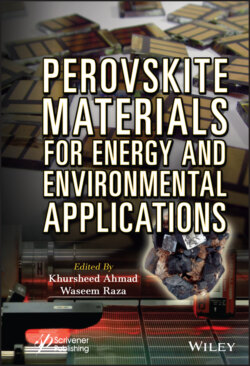Читать книгу Perovskite Materials for Energy and Environmental Applications - Группа авторов - Страница 40
2.4.1 Mesoporous Structure
ОглавлениеA typical n-i-p mesoporous structure is shown in Figure 2.6.a, ETM is on the exterior portion. The first arrangement of the PSC to be tested was a conventional n-i-p mesoporous structure in which the light-harvesting dye was replaced by the lead halide perovskite materials (CH3NH3PbBr3 and CH3NH3PbI3 ) in a traditional DSSC [3]. Mesoporous structure of PSC is widely used because of its high porosity and high surface area. As shown in Figure 2.6.a, the mesoporous n-i-p PSC consists of FTO, ETM, a mesoporous layer of metal oxide, perovskite layer, HTM, and an electrode layer. In mesoporous p-i-n PSC, the HTM layer is on the exterior portion as shown in Figure 2.6.b. The perovskite material adheres to the mesoporous structure to increase the light-absorbing area of perovskite, which results in increased efficiency. The mesoporous structure results in efficient crystallization of perovskite and electron injection [9]. There is a depletion region at the TiO2 side of the TiO2/MAPbI3 interface, which provides contribution in separation of photogenerated charge carriers and hence it results in high performance of TiO2-based cells [14]. TiO2 mesoporous layer helps to transport the electrons, block holes, and inhibit the recombination of the electron and hole pair. The electron diffusion length and recombination lifetime is governed by the mesoporous layer of TiO2 and hence is not varied by perovskite composition [15].
Figure 2.5 Depiction of two main types of PSC [12].
Figure 2.6 Schematic diagram of four types of perovskite solar cell. (a) n-i-p mesoporous structure, (b) p-i-n mesoporous structure, (c) n-i-p planar structure, (d) p-i-n planar structure [13].
The most typical mesoporous framework material is TiO2. Bi et al. achieved PCE of 20.8%, which contains TiO2 as the mesoporous layer and Spiro-OMeTAD as the electron and hole specified contacts [16]. The limitation of using TiO2 as a mesoporous layer is comparatively low electron mobility [17]. In place of TiO2, Al2O3, and ZnO have also been used as a mesoporous layer [18]. ZnO has two orders of magnitude of electron mobility higher than TiO2 [19]. The recombination rate of charge is significantly slower in TiO2 as compared with Al2O3 [20]. Also, Zn2SnO4, BaSnO3, and SrTiO3 are tested as mesoporous layers. Zn2SnO4-based PSC showed fast electron transport (up to 10 times) and greater charge collection capability as compared with TiO2-based PSC with the same physical and chemical conditions [21]. BaSnO3 has a large bandgap and relatively higher electron mobility than TiO2. BaSnO3 was able to achieve 12.3% but has a recombination rate greater than TiO2 [22]. SrTiO3 had achieved 1.01 eV open-circuit voltage, which is 25% higher than TiO2 [23]. The most common hole transport material is Spiro-OMeTAD(2,2′,7,7′-Tetrakis [N,N-di(4-methoxyphenyl)amino]-9,9′-spirobifluorene). An alternative to Spiro-OMeTAD, spiro[fluorene-9,9′-xanthene], achieved the PCE of 19.8% with low fabrication cost [16]. KTM3 showed higher Voc (1.08V) and FF (78.3%) than Spiro-OMeTAD [24]. The commonly used counter electrode materials are Ag, Au, and Pt. For large-scale and continuous production of PSC containing the mesoporous layer of TiO2, the electrospray deposition method is more viable [25].
